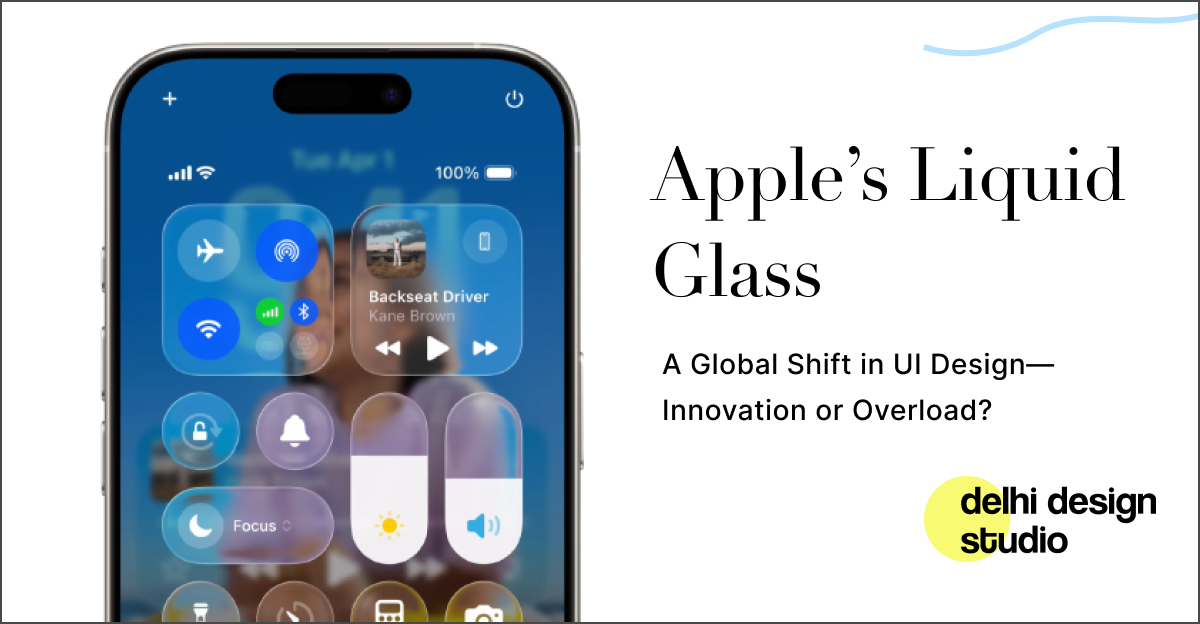
Apple’s Liquid Glass
A Global Shift in UI Design—Innovation or Overload?
By delhidesignstudio.co.in— Specialists in Global UI/UX Design Trends
Apple has revealed its most ambitious visual overhaul in over a decade: a bold new design language powered by Liquid Glass. Debuting across iOS 26, macOS Tahoe, iPadOS, and beyond, this real-time reactive material redefines how users interact with digital interfaces. At delhidesignstudio.co.in, a leading name in global UI/UX design, we analyze this transformation using key principles from Brain Rules by John Medina—and explain why it’s both powerful and problematic.
This isn't just another aesthetic upgrade. It’s a move that sets new standards for award-winning interface design, and pushes the boundaries of human-centered digital experiences.
🧠 Visual Power: Why Liquid Glass Captivates the Brain
(Brain Rule #10: Vision beats all other senses)
Why it’s a win:
Liquid Glass uses real-time reflections, transparency, and dynamic layering—exactly the kind of high-impact visuals our brains prioritize. Medina’s neuroscience findings show that vision is our most dominant sense, making visual storytelling essential to great UI/UX. At delhidesignstudio.co.in, we see Apple leveraging this to enhance user delight and emotional brand connection—critical components in best UI design practices worldwide.
But here’s the risk:
Too much visual motion can impair clarity. Global users, especially those in accessibility-sensitive markets, may find high translucency and dynamic UI layers overwhelming. From a cognitive design perspective, clarity must lead creativity—something we champion in our global design projects.
🎯 Attention Management in a Visually Noisy World
(Brain Rule #4: Attention is easily lost)
The good part:
Liquid Glass intelligently adapts interface elements—like shrinking tab bars and morphing toolbars—to maintain focus on content. This approach aligns well with the future of user experience design, where adaptive minimalism reduces cognitive load.
The concern:
Too many transitions, shifts, and context-aware changes may become visually fatiguing. Apple walks a fine line between elegant motion and mental noise. At delhidesignstudio.co.in, we optimize interfaces for sustained focus—especially important for enterprise UI design, where functionality must not be buried under aesthetics.
💡 Emotional Engagement Drives Retention
(Brain Rule #5: Emotion improves memory)
Positive potential:
Liquid Glass evokes magic—one of Apple’s strongest emotional levers. Emotion-rich designs form long-term memory associations with interfaces, increasing brand affinity. Our design team uses this exact principle in creating immersive mobile app UIs and engaging web experiences for global brands.
However:
Negative emotions—like frustration from poor legibility—also stick. That’s why human-centered digital design must consider the emotional cost of complexity. At delhidesignstudio.co.in, we always test emotional impact across diverse user demographics to ensure global relevance.
🧩 Pattern Recognition vs. Complexity
(Brain Rule #6: The brain seeks familiar patterns)
Where Apple succeeds:
Despite radical visuals, Apple has kept familiar navigation logic, icon shapes, and interaction paths intact. This respects global usability standards and enhances intuitive adoption—principles we embed in every award-winning UI/UX project at delhidesignstudio.co.in
Where it may fall short:
Layered transparency and shifting visual cues may confuse less-experienced users. Cultural usability norms vary, and what delights in one region may frustrate in another. This is why global design thinking demands inclusive testing across continents, something our team actively practices.
🌐 Cross-Platform Harmony: The New Global Standard
Apple’s new design language brings visual consistency across devices—from iPhone to Apple Watch to Mac. This mirrors a major trend in global product design: build once, adapt everywhere.
At delhidesignstudio.co.in, we champion this model through modular UI systems that scale across web, mobile, desktop, and embedded devices. Apple’s use of SwiftUI and AppKit aligns with the evolution of unified design frameworks, now a core strategy in global UX strategy.
Final Thoughts from DesignDesignStudio.co.in
Global Strengths | Potential Weaknesses |
Stunning visual clarity and delight | Risk of overstimulation |
Cross-platform consistency | Potential for accessibility issues |
Emotion-driven design language | Can sacrifice usability for aesthetics |
Real-time adaptive UI | May distract or confuse some users |
Apple’s Liquid Glass UI is a landmark moment for global digital design. It combines technological artistry with interface intelligence, pushing the envelope of what’s possible. But it also reminds us: design must serve the brain, not just the eye.
At delhidesignstudio.co.in, we help companies worldwide translate bold ideas into usable, scalable, and emotionally intelligent digital products. Whether you're adapting to new Apple platforms or rethinking your brand’s visual identity, we’re here to help you lead—not follow—the next wave of global design innovation.